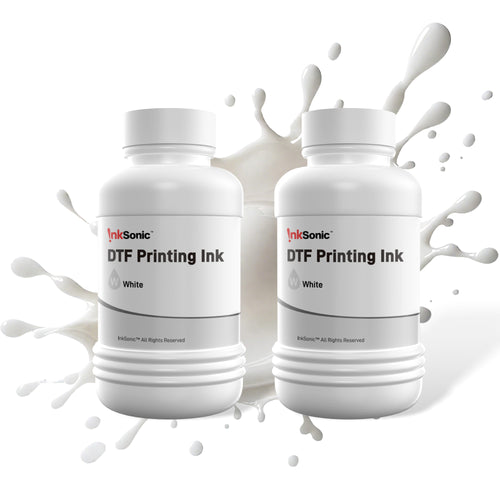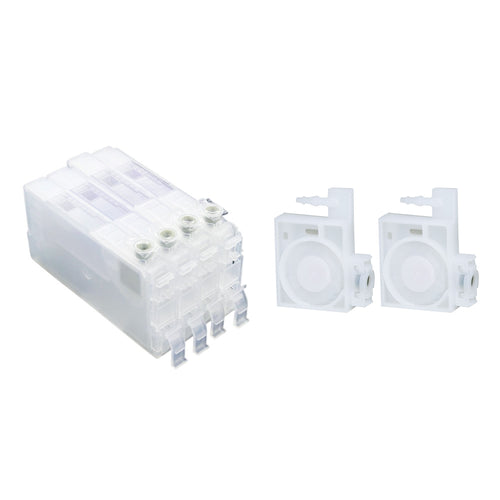If you’re in the process of starting a custom apparel business or side hustle, you’ve likely discovered one thing: print quality and speed can be the deciding factor in your success. That’s the power of DTF. DTF is a new technology revolutionizing the world of design for all types of small business owners, as it can produce beautiful, quality designs on t-shirts, hoodies, tote bags, and more. It is fast, versatile, and without the learning curve or financial commitment of older processes like screen printing and DTG.
But here's the catch - all DTF printers aren't created equal, and choosing the wrong one could cause frustrating clogs, wasted materials, and expensive downtime. You're a beginning entrepreneur, stay-at-home maker, or expanding from print-on-demand; regardless, this guide will walk you through the steps of how to find the perfect DTF printer for your small business so you can start strong, print smart, and build with confidence.
What is DTF Printing?
DTF, or Direct-to-Film printing, is a modern method of printing that allows you to create vivid, full-color artwork and transfer it onto anything from cotton to leather with ease of uncomplicated simplicity. The process is actually quite easy: you print your design on special PET film with DTF ink first, then add a layer of adhesive powder to the wet print, then cure the powder using heat, then finally apply the design to your garment using a heat press. In contrast to DTG (Direct-to-Garment) printing, pre-treated and ideal for cotton, or sublimation, only for white polyester, DTF printing works on cotton, polyester, blends, and even dark colors— without pre-treatment. DTF is faster, cleaner, and far easier for a beginner to use than screen printing, especially for small runs or custom runs.

DTF (Direct-to-Film) printed product sales are increasing rapidly, driven by the world-wide surge in enthusiasm for customized shirts and personalized products. A Grand View Research report in 2024 estimates the custom T-shirt printing industry alone at $9.9 billion by 2030, with a CAGR of 9.9% from 2023 to 2030, and DTF as one of the most inexpensive and scalable solutions available for small businesses. DTF is projected to flourish due to the growth of e-commerce platforms, the rise of social media-only trends, and the growing appeal of niche fashion and custom goods. Through being able to print bold designs on any form of fabric—cotton, polyester, or blends—DTF has empowered entrepreneurs to sell to a wider market than previously possible. From petwear and streetwear to totes and work wear, DTF-printed products are filling a massive and lucrative space in the global custom merchandise industry.
Why DTF Printing is Ideal for Small Businesses
DTF (Direct-to-Film) printing is a powerful option for small business owners looking to break into the custom apparel or product printing market. One of the biggest advantages is its low startup cost . While screen printing requires multiple mesh screens and expensive setup for each design, and DTG (Direct-to-Garment) demands costly pre-treatment equipment and maintenance-heavy printers, DTF printers are far more affordable and efficient to operate.
DTF also excels in versatility —you can print on cotton, polyester, blends, light or dark fabrics , and even on materials like canvas or leather, which many other methods struggle with. Unlike HTV (heat transfer vinyl), there’s no need for weeding , and unlike DTG, there’s no pre-treatment required —meaning faster production and lower labor costs.
With a short learning curve , even beginners can learn the DTF process in just a few days and start producing sellable products quickly. Combined with its ability to handle on-demand or small-batch custom orders , DTF helps entrepreneurs keep inventory low while delivering personalized, high-quality items—making it one of the fastest routes to ROI (return on investment) in the print industry.
Feature/Method |
DTF Printing |
Screen Printing |
DTG Printing |
Sublimation Printing |
Startup Cost |
Low |
High (screens, inks, setup) |
High (printer + pre-treatment machine) |
Moderate (printer + sublimation paper) |
Fabric Compatibility |
Cotton, polyester, blends, darks |
Mostly cotton |
Primarily cotton |
Only light polyester |
Pre-treatment Required |
No |
No |
Yes |
Yes |
Weeding Required |
No |
No |
No |
No |
Print Quality |
High (vivid, full color) |
Very high (for bulk/simple designs) |
High (on cotton) |
High (on poly) |
Learning Curve |
Short (easy for beginners) |
Steep (manual labor + setup) |
Moderate (requires technical know-how) |
Moderate |
Production Speed |
Fast for small batches |
Very fast for large runs |
Slower (single garment at a time) |
Fast (after setup) |
Ideal Use Case |
Small batches, custom orders |
Large bulk orders |
Custom cotton apparel |
Personalized items like mugs, shirts |
Maintenance |
Low to moderate |
Low |
High (cleaning printheads, pre-treat) |
Low |
ROI Potential |
Fast |
Slower unless high volume |
Moderate |
Moderate |
Key Factors to Consider When Choosing a DTF Printer
When choosing the best DTF printer for your startup business, it is critical to recognize what impacts performance as much as long-term value. Print size is among the main parameters to focus on. A4 devices are compact and budget-friendly and are ideal for printing tiny designs like chest logos, clothing tags, or arm prints. For the sale of full-size t-shirts, tote bags, or personalized patches, the most supportive option is an A3 printer. For those expecting higher output or larger format printing, A2 printers provide more capacity but at a higher price point.
Quality of printhead and print resolution also play an important role in the final product. 1440x1440 DPI resolutions are sufficient for minor jobs, but 2880x1440 DPI prints more defined, color-filled prints. Printhead types such as XP600, L1800, or i3200 influence speed and definition as well. XP600 offers good speed for growing businesses, while L1800 is known for its color accuracy.

Pay attention to the white ink management system , as this ink type tends to clog easily. Printers with automatic stirring, circulation, and filtering will save you hours of maintenance.
Design features such as a built-in heater , air suction platform , and precise temperature control help ensure smooth, wrinkle-free printing—especially in colder climates where curing the ink is much more difficult.
Ease of use and easy maintenance count, especially if you are a beginner, so look for a printer with intuitive controls and easy cleaning, along with accessible tech support. Don’t just consider the initial cost —look at ongoing expenses like ink, PET film, powder , and maintenance supplies. A reliable DTF printer should pay itself off in just a few months with steady orders.
Lastly, strong after-sales support is crucial. Even for plug-and-play products, sometimes you may need to consult the product's after-sales team if you don't understand how to operate them, not to mention large items like DTF printers. If you can't get a timely response to the problems you encounter, it will affect your production efficiency.
Top Recommended DTF Printers for Small Businesses
If you're starting a small business and looking for the best DTF printer to match your needs and budget, InkSonic offers several highly rated options, each tailored to different stages of business growth.
InkSonic XP600 U13 is ideal for entrepreneurs planning to scale. With XP600 printheads, it delivers fast print speeds and consistent quality, making it perfect for handling higher-volume orders. Its performance and speed suit it well to stores that offer a wide range of products ranging from t-shirts to hoodies and large format prints. Powerful as it is, it is easy to use and hence a perfect choice even for start-ups who need the space to grow.
InkSonic L1800 E13A is a compact A3-format DTF printer that strikes the perfect balance between quality and affordability. Known for its vivid color output and smooth operation, it's ideal for home-based businesses or side hustlers.
For those just starting out and watching every dollar, the InkSonic R1390 is the most cost-effective choice. It offers excellent print quality comparable to the L1800 but with reduced maintenance expenses , making it a smart entry-level option for budget-conscious creators. It offers lower maintenance costs and is great for producing shirts, tote bags, pet apparel, and small custom runs.
Common Mistakes to Avoid When Buying Your First DTF Printer
Buying your first DTF printer is an exciting step—but it’s also where many new business owners trip up. You might be tempted by a super cheap printer you found online. The pictures look great, the specs sound decent, and the price? Almost too good to be true. And that’s the problem—because it probably is. Many no-name machines come with vague manuals, zero support, and unreliable parts. Before long, you're dealing with clogged printheads, botched prints, or worse—dead machines, and no one picking up your support calls. Then there’s the white ink. It might seem like just another bottle in your starter kit, but if your printer doesn’t have a proper circulation system, it’ll settle, harden, and clog your nozzles faster than you’d expect. It’s one of the most common causes of early breakdowns.

Maybe you're thinking in terms of dozens of orders right away, so you splurge on a huge printer. But when reality bites—you're getting fewer orders, tighter space, and more maintenance than you hoped for—you're stressed out and stretched to the limit. And don't even speak of the hidden costs: ink, powder, PET film, cleaning supplies. These can quickly add up, especially if you didn't budget for them. The truth is, small and intelligent will treat you a whole lot better. Select the appropriate equipment for where you are—rather than where you aspire to be sometime soon—and you'll position yourself for actual, long-term growth.
Here’s a quick checklist to help you pause and evaluate before making your purchase:
What’s my realistic order volume for the next 3–6 months?
(Avoid overbuying—bigger isn’t always better.)Do I have space and proper ventilation for printing and curing?
(Even small printers need a safe, clean setup.)Does this printer include a white ink circulation system?
(If not, you’re risking costly clogs and downtime.)What kind of after-sales support is available?
(Check if there's real-time help, tutorials, or spare parts access.)Have I calculated the ongoing supply costs—ink, film, powder, maintenance?
(Your budget shouldn’t stop at the printer price.)
Asking these questions upfront could save you from expensive headaches down the line and help you choose a printer that truly supports your business goals.
Curious whether a DTF printer might be the right investment for your business? This article can help you explore the possibilities.
Frequently Asked Questions (FAQ)
Q1: How much does it cost to get started with DTF printing?
A: Entry-level DTF setups typically range from $800 to $2,500 , depending on the printer model. Don’t forget to budget for inks, PET film, adhesive powder, a heat press, and a curing method (oven or heat gun). Many businesses get fully set up for under $3,500 .
Q2: How often do I need to maintain my DTF printer?
A: Daily maintenance is minimal but essential. This includes printhead cleaning, checking ink levels, and ensuring your white ink circulation system is working. Proper care can prevent clogs and extend your printer’s lifespan.
Q3: Is DTF printing applicable on products such as hoodies or canvas bags?
A: Yes. DTF is highly versatile. DTF works on cotton, polyester, blends, denim, canvas, and even leather. You can use DTF on hoodies, tote bags, hats, patches, and more.
Q4: What’s the typical ROI (Return on Investment) for a small DTF setup?
A: Most small businesses begin to break even in 2–4 months , depending on order volume and pricing. Because of low per-print costs and high margins, DTF can offer a fast and sustainable path to profitability.
Q5: What happens if I don’t use the printer for a few days?
A: White ink can settle, and if you are gone long enough, it can cause printheads to clog. You want to buy a printer with automatic white ink circulation, or if it doesn’t have that email option, you can stir the white ink at least once a day and do that every day while you’re not using it. This way, you will avoid the print head from clogging.
Q7: Do I need design skills to get started?
A: Not at all! A lot of people start out just using someone else's designs that are sold on places like Etsy, or in-market designs, your sticker printer will have a design or create something for you in your area. That said you can get by with basic design tools, like Photoshop or Illustrator, and free apps like Photopea, if you really want to custom design your own graphics.
Q8: What’s the difference between A3 and A4 DTF printers?
The A3 and A4 DTF Printers differ by print size. An A3 printer can do larger designs as well as more items at once. So if your business will depend on high volume output, or you think you will fare extensive detailed and complex designs, you may want to get the A3 model.
Q9: How often should I do maintenance on my DTF printer?
The frequency of playback and usage determine the regularity of maintenance, however, in general, you should always clean the printheads at least once a week, some say once every other week to keep it clean. You can also choose a self-cleaning model so the printer will clean itself. Make sure to carefully follow the instructions in the manual to achieve optimal print conditions.
Q9: How long does a DTF printer last?
It can vary, depending upon the model and nature of usage, but often a well cared for model can last 5 – 10 years. Durable machines can last much longer and offer better quality and value.







































